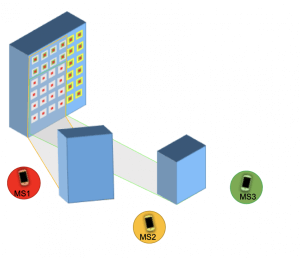INTERACT Podcast
In this podcast talk, we will focus on reliability in wireless communications focusing on vehicular use cases and scenarios. It is trivial to say that without reliable message exchange, safe driving is not possible; however, continuously increasing demands for wireless communications in the context of intelligent transportation systems (ITS) cause that reliability is becoming a dominant factor when discussing wireless message delivery. So, what does it mean nowadays to send data reliably, is 99.999% of correctly delivered messages enough to treat vehicular systems as reliable? How would it change in the future? To address these questions, private docent (Priv.-Doz. DI Dr. techn.) Thomas Zemen has kindly agreed to discuss reliability-related issues with us. Thomas is with AIT Austrian Institute of Technology and TU Wien. Thomas, it is a pleasure to welcome you here, and I would like to thank you for accepting our invitation to the talk!
Talk at Gdansk University, “Digital Twin for Reliable Vehicular Wireless Links”
Stefan Zelenbaba presented his work on wireless digital twins. The stringent reliability and latency constraints imposed by URLLC require the development of affordable and repeatable testing and verification methodologies. Stefan Zelenbaba explained: „We built an SDR-based multi-node wireless channel sounder to collect measurement data in complex vehicular communication scenarios. The measurement data is used to calibrate a realistic geometry-based stochastic channel model, that simulates the measured scenario. By combining our realistic channel model with the AIT real-time wireless channel emulator, we create a site-specific digital twin for testing reliable vehicular links using transmitter and receiver modems in the loop.“
Keynote at OVE-IT-Colloquium “5G as the basis for digitization. Applications, opportunities and outlook for 6G”
5G, the fifth generation of communication networks, is now generally available to the public.
This year's IT Colloquium is dedicated to industrial applications of 5G. Concrete application examples demonstrate the benefits of data communication with extremely low error rates and low latency as well as the networking of things with very low power consumption. This also reveals the technical limits of 5G and the research goals for the future 6G.
Novel wireless vehicular channel measurement dataset including LIDAR data featured in COST INTERACT newsletter
In collaboration with the RELEVANCE project we gathered radio propagation measurements in vehicular scenarios in parallel with LIDAR (light detection and ranging) data. This data set enables new insight in dynamic radio propagation conditions in mobile vehicular scenarios with multiple vehicles. The data set will be published on http://relevance.ait.at. This work was presented at the last COST INTERACT workshop in February 2022 in Bologna and is featured in the lastest newsletter .
Interview, Futurezone
AIT expert Thomas Zemen on the opportunities 5G opens up and the potential of the next mobile communications standard.
Smart cities, autonomous cars, networked machines in industry - the new 5G mobile communications standard could be the key to all these innovations. Because the next generation of mobile communications promises more than just faster Internet. "It's about better interaction between machines and people," says Thomas Zemen, Principal Scientist at the AIT Austrian Institute of Technology, in an interview with futurezone.
Use case article, “Flexible Production with 5G”
Modern 5G communication systems enable more secure, cost-effective, reliable and environmentally friendly operation of many technical systems - for example, in business and transport, where time-critical applications require reliable wireless communication systems with short latency (maximum one millisecond delay) and high reliability (over 99.999 percent) (German article).
Presentation at ADV Austrian Digital Value, Sustainability 4.0, “Wireless 6G for Green”
Modern 6G communication systems enable safer, more cost-effective, more reliable and more environmentally friendly operation of many technical systems - for example in industry and transport, where future safety-critical applications require reliable wireless communication systems with short latency (maximum 0.1 millisecond delay) and high reliability (over 99.99999%). 6G systems reduce energy consumption and increase competitiveness - in line with the European "Green Deal" goals of improved resource efficiency and lower greenhouse gas emissions.
Keynote at 60th FITCE Communication Days, “Ultra reliable wireless 5G + 6G communication links”
An outlook on new applications that demand time-critical 6G communications with ultra-low latency and high reliability.
Panel discussion, ADV Austrian Digital Value, “5G / Infrastructure”
5G is now available and a central component for the digitization of many applications. Research on 6G has already begun. As a user, you can now benefit from the 5G broadband connection first. However, this is only one dimension of the 5G standard. The revolutionary aspect of 5G lies in two new dimensions that are central to digitization.
Interview, Die Presse
5G technology is currently being rolled out worldwide. At the AIT Austrian Institute of Technology in Vienna, Thomas Zemen has long been researching 6G.
Presentation at Imagine 21, “High-tech made in Austria: 6G and other future technologies”
The mobile networking of people, but also of machines and physical objects, is advancing inexorably, and 5G technology is in the process of global rollout. To provide highly reliable communication for industrial control systems, robots, autonomous systems and much more during the digitalization of our society, further technical developments are required.
Project Kick-Off

Project DEDICATE started to work on three initial directions: wide aperture arrays, reflective intelligent mmWave surfaces, and quantum radio frequency sensing.

